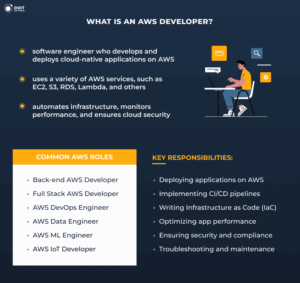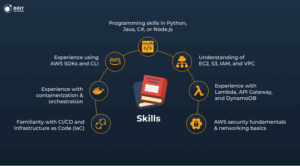AWS developers are software engineers who design, build, deploy, and manage applications for the Amazon Web Services cloud platform. An AWS expert uses the vast suite of AWS services for compute, storage, databases, networking, and more.
Each time you build an application on AWS, you need a developer who understands how to select the right services and configure them. Doing so ensures your app can handle user traffic and run efficiently without going over budget. And a clear AWS developer job description is your first step to finding the right person for this role.
In this article, you’ll learn about the role of an AWS developer, their types, responsibilities, and qualifications. Moreover, you’ll find a customizable template you can use for your AWS engineer job description right away. So, let’s get started!
Before moving into a complete guide, here is a quick template to help you start writing your own AWS developer job description. Remember to customize it with specifics about your project architecture, team, tech stack, and company culture.
AWS Developer Job Description
We are seeking an experienced AWS Developer to join our engineering team. In this role, you will be responsible for {{ developing / maintaining / migrating }} our cloud-based systems on AWS. Your primary focus will be designing and implementing solutions using {{ list 2-3 core AWS services }}. This position requires a strong understanding of cloud-native architecture and modern development practices.
Responsibilities
▪ Design secure and reliable cloud-based architecture for the AWS platform.
▪ Implement Infrastructure as Code with CloudFormation or Terraform.
▪ Configure CI/CD pipelines.
▪ Deploy and manage containerized applications.
▪ Collaborate with DevOps teams to automate deployment processes.
▪ Implement security measures and data protection protocols.
▪ Monitor application performance, identify bottlenecks, and suggest improvements to it.
▪ {{ Add other responsibilities specific to your project requirements }}
Skills and Qualifications
▪ Hands-on experience with core AWS services, such as EC2, S3, API Gateway, and VPC.
▪ Familiarity with containerization with Docker and orchestration with Amazon ECS or EKS.
▪ Experience implementing Infrastructure as Code using CloudFormation or Terraform.
▪ Able to implement and manage CI/CD pipelines using AWS CodePipeline and Jenkins.
▪ Experience with AWS database services: RDS, Aurora, DynamoDB, or Redshift.
▪ Strong understanding of cloud security and IAM role management.
▪ Experience with monitoring using CloudWatch or similar tools.
▪ Able to create and maintain system documentation.
▪ Proficiency in at least one programming language, such as Python, Java, JavaScript (Node.js), or Go.
▪ Proficiency with serverless architecture patterns with Lambda is a plus.
▪ Proficient with code versioning tools like Git.
▪ {{ Include any additional tools relevant to your stack }}
▪ {{ Specify required education level or years of experience }}

As mentioned above, an AWS developer is a software engineer who specializes in building apps that run on the Amazon Web Services platform. Unlike a traditional developer who might work on on-premise servers, an AWS developer uses cloud services across these categories:
Moreover, the role and responsibilities of an AWS developer can vary based on their area of specialization and level of experience. For instance, some may focus only on backend services, while others might manage the entire app stack or even automate the infrastructure it runs on. Let’s take a further look.
To find the right candidate, you must first identify the specific type of developer you need. Here are some of the typical roles you might consider when writing an AWS job description.
Now, let’s take a closer look at how responsibilities change with experience. The tasks you assign to a junior developer will be quite different from the strategic work you expect from a senior one.
A junior AWS developer typically works under the guidance of more senior team members. They focus on well-defined tasks to build their skills with the AWS platform. They usually have 0-2 years of experience.
A junior AWS developer job description often includes these duties:
A middle AWS developer operates more independently and takes on greater ownership of features. They have 2-5 years of experience and understand how different AWS services work together.
Here are the everyday responsibilities for middle AWS developers:
A senior AWS developer is responsible for the big-picture architecture and technical strategy. They have 5+ years of experience and can lead projects, make critical design decisions, and ensure the team follows best practices for building on AWS.
Here’s what senior AWS developers typically do:

Moving forward, it’s time to focus on the specific qualifications you should include in your AWS developer job description. A successful candidate combines strong programming skills with deep knowledge of the AWS platform and modern development practices.
Here are the primary AWS developer qualifications and technical skills to look for.
Besides core technical skills, you can also look for an educational background or certifications. While they aren’t a must-have, many organizations require a relevant degree, especially for junior roles, where candidates don’t yet have commercial experience.
Most AWS developers hold a Bachelor’s degree in Computer Science, IT, Software Engineering, or related technical fields. However, bootcamp graduates and self-taught developers with strong portfolios also succeed in AWS roles.
As for the certifications, AWS provides several relevant official exams:
Besides, there are also some specialized certifications you can consider (e.g., AWS Certified Machine Learning Engineer, AWS Certified Data Engineer, AWS Certified Security, and AWS Certified Generative AI Developer).
We hope this guide provides a clear roadmap for creating an effective AWS developer job description. Remember to clearly define the specialization you need, the seniority level you are targeting, and the specific technical skills required for your projects.
When you are ready to find a professional who matches your requirements, you can simplify the search by partnering with DOIT Software. The DOIT team can help you find highly skilled AWS developers from our global network across the US, Europe, and LATAM. Just contact us, and our talent matchers will conduct a thorough assessment of the candidate’s technical and soft skills to fit your existing team.
Get a consultation and start building your dream team ASAP.
Request CVsAn AWS developer’s primary role is to design, build, deploy, and maintain applications on the Amazon Web Services cloud platform. They use AWS services for compute, storage, databases, and more to create secure software solutions that meet specific business needs.
The amount of coding varies by specialization. Backend AWS developers write more application code while DevOps engineers focus more on automation scripts, but all AWS Developer roles require strong programming skills.
Usually, AWS developers write application code in languages like Python, JavaScript (Node.js), Java, or Go to build the business logic that runs on AWS infrastructure. They also write scripts to automate infrastructure provisioning using CloudFormation templates or Terraform configurations. Beyond application code, AWS developers create deployment scripts, write tests, and implement monitoring solutions.
An AWS developer job description outlines responsibilities for building applications specifically designed for cloud infrastructure. It typically includes writing code for cloud-native applications, deploying services using CI/CD pipelines, managing infrastructure as code, and optimizing applications for performance, security, and cost on the AWS platform.
The key is specificity. Start by clearly identifying the core AWS services your team uses daily. Specify whether the role focuses on new development, system maintenance, or a migration project. Briefly describe your current architecture and any interesting challenges a new hire would help solve. Finally, be clear about the level of architectural decision-making and autonomy you need.










